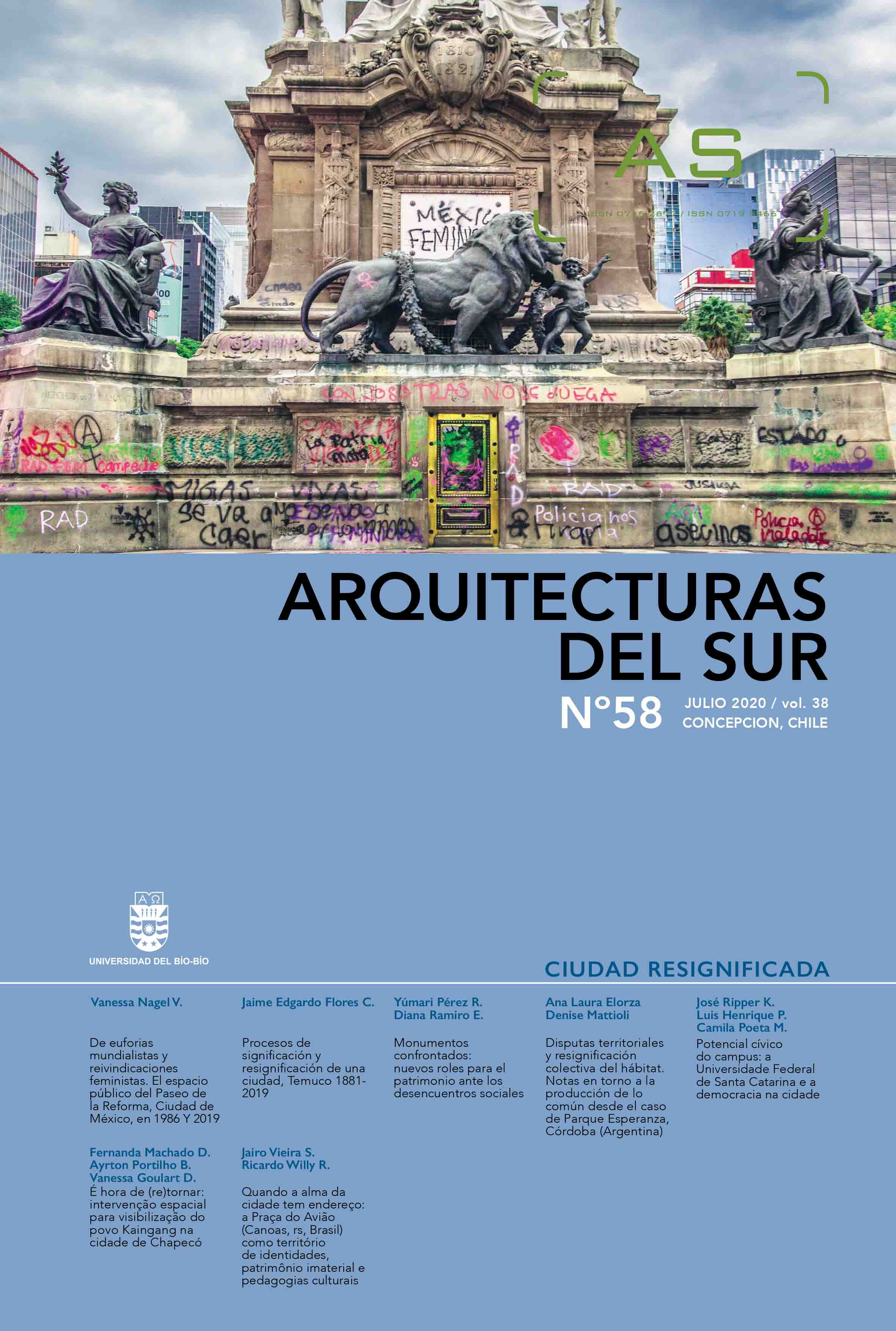Confronted monuments: new roles for heritage in the face of social disagreements
DOI:
https://doi.org/10.22320/07196466.2020.38.058.03Keywords:
monuments, cultural heritage, restoration theory, social movements, memoryAbstract
The attacks on monuments —street art, mutilations, being brought down— that have been seen around the world recently, cannot go unnoticed by heritage academics. It is a phenomenon that heralds the obsolescence of ideas and theories adopted so far on heritage and its conservation. Throughout this work, reflections are made about heritage as cultural heritage, explaining how commemorative monuments differ from historical monuments, a topic that comes under the limelight when talking about museification and petrification of heritage. To give context to this phenomenon, three attacks on monuments are addressed the march of November 8th, 2018 in Santiago de Chile, when people brought down statues in the US and England within the Black Lives Matter movement and the #NoMeCuidanMeViolan movement, in Mexico. The reflection considers the motivations behind these actions against heritage, the reactions of hegemonic groups and, more than anything, the resignifications and redefinitions that are taking place or could take place, as a result of all this, about cultural heritage.
Downloads
References
Actualidad. (2019). 09 noviembre 2019. Revisado en: https://actualidad.rt.com/actualidad/333079-perdida-gigantesca-incendio-universidad-chile
BUCHANAN, L., BUI, Q. Y PATEL, J. (3 de julio de 2020). Black Lives Matter May Be the Largest Movement in the U.S. History. The New York Times. Recuperado de https://www.nytimes.com
CHOAY, F. (2007). Alegoría del patrimonio. Barcelona, España: Gustavo Gili.
RIEGL, A. (1999). El culto moderno a los monumentos: Caracteres y origen. Madrid: Visor.García, C. N. (2009). La globalización imaginada. Barcelona: Paidós.
DELGADO, M. (2011) El espacio público como ideología, Madrid: Catarata
El Día. (2019). 26 de octubre 2019. Revisado en: http://www.diarioeldia.cl/magazine/alcalde-no-removera-estatua-mujer-diaguita-se-abre-dialogo
FLORESCANO, E. (1999). El patrimonio nacional. Valores, usos, estudios y difusión. En E. Florescano, El patrimonio nacional de México I (págs. 15-27). México: Consejo Nacional para la Cultura y las Artes, Fondo de Cultura Económica.
GARCÍA C. N. (1999). Los usos sociales del Patrimonio Cultural. En E. A. Criado, Patrimonio etnológico: nuevas perspectivas de estudio (págs. 16-33). España: Junta de Andalucía, Instituto Andaluz del Patrimonio Histórico.
GARCÍA, C. N. (2009). La globalización imaginada. Barcelona: Paidós.
GONZÁLEZ-VARAS, I. (2014). Las ruinas de la memoria. Ideas y conceptos para una (im)posible teoría del patrimonio cultural. México, S.XXI Editores
Infobae (2019). 08 noviembre 2019. Recuperado en: https://www.infobae.com/america/america-latina/2019/11/08/a-tres-semanas-del-inicio-de-las-protestas-miles-de-jovenes-se-mantienen-en-las-calles-de-chile-contra-el-gobierno-de-pinera/
MARCOS, J. (2010). El patrimonio como representación colectiva. La intangibilidad de los bienes culturales. En Gazeta de Antropología N° 26/1, artículo 19, Universidad de Granada, recuperado de http://hdl.handle.net/10481/6799 el 17 de noviembre de 2019
Proceso. (2019). 27 agosto 2019. Revisado en: https://www.proceso.com.mx/597371/pintas-a-monumentos-historicos-son-una-agresion-a-todos-dice-gutierrez-muller
Restauradoras con Glitter (2019) Carta abierta dirigida al Presidente de la República Mexicana Lic. Andrés Manuel López Obrador y la Jefa de Gobierno de la CDMX Dra. Claudia Sheinbaum el 21 de agosto de 2019. Recuperada de https://www.facebook.com/restauradoras.glitterMX
The New York Times. (2020). 08 junio 2020. Recuperado en: https://www.nytimes.com/2020/06/08/world/europe/edward-colston-statue-britain-racism.html
The New York Times. (2020). 03 julio 2020. Revisado en: https://www.nytimes.com/interactive/2020/07/03/us/george-floyd-protests-crowd-size.html
THOREAU, H. (2014). Desobediencia civil y otros textos. México, Universidad Autónoma de Morelos.
UNESCO. (2014). Indicadores UNESCO de Cultura para el Desarrollo. París.
YOUNG, J. (1992). The Counter-Monument: Memory against Itself in Germany Today. Critical Inquiry, 18(2), 267-296.
Downloads
Published
How to Cite
Issue
Section
License
Copyright (c) 2020 Yúmari Pérez-Ramos, Diana Ramiro-Esteban

This work is licensed under a Creative Commons Attribution-ShareAlike 4.0 International License.
The content of the articles published in each issue of Arquitecturas del Sur is the sole responsibility of the authors and does not necessarily represent the opinion of University of the Bío-Bío.
The authors will maintain their copyright; however, they will guarantee the journal the right to first publication and dissemination of their work. The publication of the article in Arquitecturas del Sur will be subject to the Creative Commons International license (CC BY-SA) that allows others to adapt: remix, transform and build on the material for any purpose, even commercially; share: copy and redistribute the material in any medium or format, as long as the authorship and first publication in this journal are acknowledged by citing them correctly, and their new contributions are under a license with the same terms.














 Programa de Información Científica/Concurso Fondos de Publicación de Revistas Científicas 2018/ Proyecto Mejoramiento de Visibilidad de Revistas UBB (Código:FP180007)
Programa de Información Científica/Concurso Fondos de Publicación de Revistas Científicas 2018/ Proyecto Mejoramiento de Visibilidad de Revistas UBB (Código:FP180007) 
